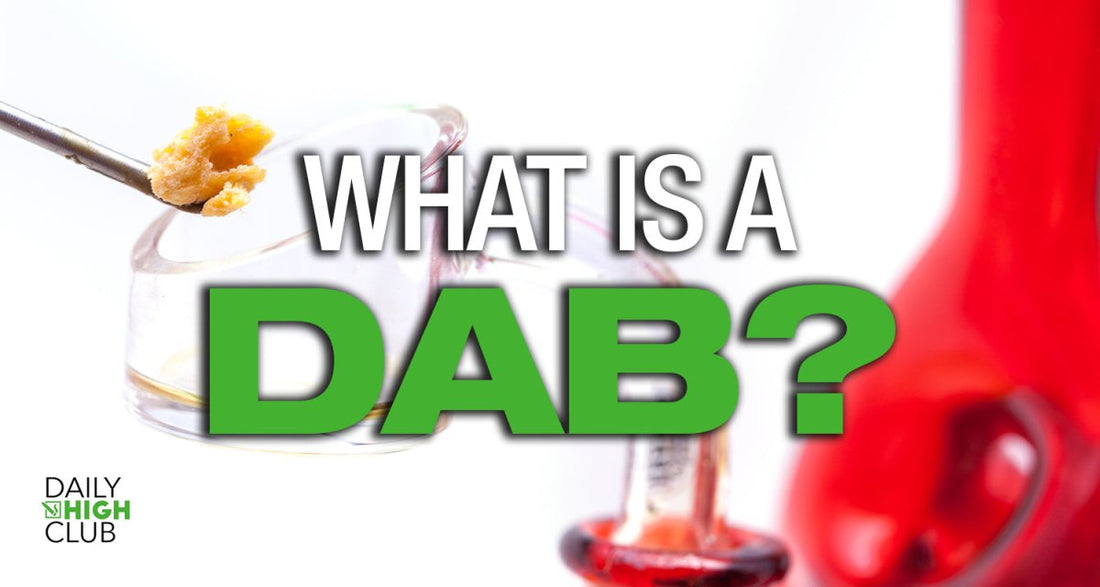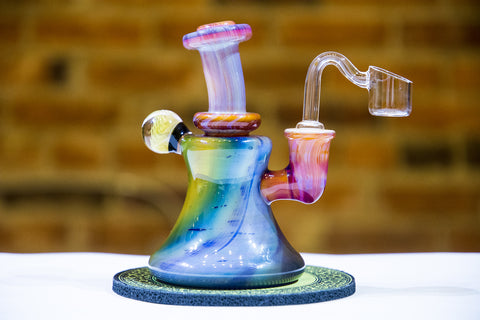
What is a Dab?
By Adam FrostUpdated November 2023
Dabbing concentrates has never been more popular than it is today, with an increased availability of both concentrates and types of dab rigs available to consume them.
Although it's been around for a while now, the art of dabbing is still relatively new, and those new to dabbing may be wondering what a dab even is.
In this guide, we will explore the question: what is a dab? We'll also look at the types and benefits of dabs, the history of dabbing, and how concentrates are extracted. Finally, we'll go over how to use a dab rig so you can be ready to dab by the end of this article!
To learn more about dabbing, check out our comprehensive Dab Rig Encyclopedia!
What is a Dab?
"Taking a dab" refers to consuming highly concentrated extracts, also known as concentrated Butane Hash Oils (BHO). There are multiple forms of cannabis extracts, or "dabs," depending on the extraction method used.
Dabs have higher concentrations of all cannabinoids, including a higher THC content (tetrahydrocannabinol) than regular flower, making them far more flavorful and potent than smoking flower. To consume, all you need to do is to bring the concentrate to vaporization temperatures, which results in smooth and delicious vapor instead of harsh smoke.
They're usually consumed using dab rigs, nectar collectors, and even vape pens if the concentrate is pure enough.
The History of Dabbing
The history of dabbing dates back several decades, but it gained significant popularity in the cannabis community during the 2000s and onward, thanks to cannabis legalization. However, concentrated forms of cannabis like hashish, an ancient concentrated form of cannabis used in Asia for medical and religious purposes, date back thousands of years.
In the 20th century, the chemist Roger Adams was the first to produce cannabinoid isolates, and Stanley P. Lovell made the first THC concentrate besides hash oil. Finally, in 1964, Dr. Raphael Mechoulam discovered how to isolate THC, which made it easier to develop modern concentrates.
Nowadays, dabs are commonly produced and consumed in states like California and Colorado.
How Concentrates are Extracted
Some common extraction methods include:
- Solvent-based extraction: This method involves using solvents like butane, propane, or CO2 to dissolve compounds from the plant material. The resulting solution is then purged to remove residual solvents, leaving the precious concentrated extract behind.
- Solventless extraction: This technique doesn't involve the use of chemical solvents. Instead, it utilizes methods like ice water extraction (making bubble hash) or heat and pressure (rosin pressing) to separate the trichomes (where the cannabinoids and terpenes are found) from the plant material in a more natural way that avoids any contaminants.
- CO2 extraction: Utilizes pressurized carbon dioxide to extract cannabinoids and terpenes from the plant, resulting in a highly pure extract.
Depending on the intended use, these extracted concentrates are then further processed and can be used directly for dabbing or incorporated into various products like edibles, tinctures, and topicals.
Benefits of Dabbing
Dabbing has multiple benefits, including:
- Potency: Thanks to the high levels of THC, the effects of dabbing can be significantly more potent than those of traditional cannabis. This means a more powerful cannabis experience that is perfect for even seasoned smokers accustomed to the effects of regular cannabis use.
- Reduced Inhalation of Plant Material: When smoking cannabis flower, you inhale burnt plant material. Dabbing concentrates is achieved at temperatures lower than those needed for combustion, allowing you to inhale practically only the active ingredients.
- Flavor and Terpene Profiles: Cannabis concentrates are made out of terpenes, the compounds that give the plant its flavors and effects. This translates into a more flavorful and aromatic experience compared to smoking flower.
- Customizable Experience: Dabbing allows for precise dosing and control over the amount consumed, leading to a more tailored and predictable experience.

Types of Dabs
Here are details on some popular types of cannabis concentrates you can find at your local dispensary:
Wax
Wax is a type of cannabis concentrate that has a soft, wax-like consistency. It's typically made using solvents like butane, CO2, or ethanol, which are then purged to leave a concentrated substance. The texture and consistency of wax can vary from a softer, more malleable form (budder) to a more brittle texture (crumble), depending on the extraction method and post-processing techniques.
Shatter
Shatter is a translucent, glass-like cannabis concentrate that is known for its brittle texture. It gets its name from its appearance, which can resemble pieces of shattered glass. Shatter is also created by extracting cannabinoids and terpenes using solvents and then purging the residual solvents to achieve a stable and glassy texture.
Live Resin
Live resin is a concentrate made from fresh plant material that has been flash-frozen immediately after harvest to preserve the plant's terpene profile, locking in the volatile compounds that make up a strain's aroma and flavor. Live resin is often considered more aromatic and flavorful than concentrates made from dried and cured cannabis.
Live Rosin
Live rosin is a solventless concentrate made by applying heat and pressure to fresh or freshly frozen cannabis buds. This process, known as rosin pressing, produces a high-quality concentrate that retains the plant's terpenes and cannabinoids. "Live" in the context of rosin refers to the freshness of the starting material.
How to Use a Dab Rig
Dab rigs are water pipes similar to bongs but made for smoking dabs instead of smoking dry herbs.
To use one for the first time, fill your dab rig with enough water to cover the percolator or the downstem. Then, take a small amount of your chosen concentrate and place it on the tip of the dabber tool. Put it aside as you use the blowtorch or e-nail to heat the dab nail. The ideal temperature for most concentrates is between 315°F to 900°F (157°C to 482°C). Quartz and ceramic nails generally heat up faster but also lose heat more rapidly, while titanium retains heat longer.
Once the nail is heated, turn off the torch and wait about 30 seconds for the nail to cool down, then gently touch the concentrate-loaded dabber to the inside surface of the nail while inhaling slowly through the mouthpiece of the dab rig. The heat instantly vaporizes the concentrate, creating inhalable vapor.
Check out our post, How to Use a Dab Rig, to learn more!
Now that you know what a dab is, the types and benefits, and how to dab, the next step is up to you! While the potency of dabbing can be daunting to some, if you start small, you can find your sweet spot, ensuring a most enjoyable dabbing experience. With that, we wish you happy dabbing from Daily High Club!

